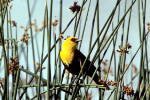
“And, for your information, you Lorax, I’m figgering
on biggering
and BIGGERING
and BIGGERING
and BIGGERING…”
I am small, and the things I love are often small too. Those who already know me know of my recent infatuation with tubificid worms. The spot after which this website is named is a tiny constructed wetlands, created in 1994 with funding from the Montana Department of Transportation wetlands mitigation program, near the East Gallatin River in Montana. (The East Gallatin was called the Cherry River by early European visitors, due to an abundance of chokecherry in the area.) In acreage, the place is highly unremarkable. Yet I love it disproportionately to its size; a brief circuit typically involves encounters with many blackbirds (both red-winged and yellow-headed), wild ducks, coots, muskrat, deer, wildflowers, bees and butterflies, and perhaps a graceful snake or two, slipping into the water. Not to mention an unsurpassed vista of lush grasses backed by the gorgeous Bridger mountains.
Small wetlands are not inconsequential. Seen from the perspective of an aquatic or semi-aquatic creature, each pond or marsh is an island. Small wetlands are the stepping-stones that make travel possible between one large island and another… as well as being valuable habitat in their own right. And yet isolated wetlands are not protected by the Clean Water Act (“isolated” = no surface water connection, due to a strict interpretation by the Supreme Court last year), and wetlands below a certain size often will not require a full permitting process to destroy.
**
How often, as progressives, do we find ourselves defending things that are small? What do we fight for? “Small farms.” Small cars. “Local businesses,” which means small businesses—and if we discover a business we like is a chain, don’t we take comfort in its being “just a small chain”? Microcredit, the new fad. Small presses, small donors. “The little guy.”
The small arrays itself against the Big: “big business.” “Big Pharma.” Big honking SUVs. “Big Oil.” “Big Ag.” Big box stores. In what seems sometimes a startling turnabout, we’re not even the party of Big Government anymore.
So, we who embrace our littleness, maybe we have to relearn how to think in smaller ways. Everything in our culture teaches us to think big. To “see the bigger picture,” generalize, abstract, and never miss the forest for the trees. Why does no one ever point out that “the forest” is just a collective abstraction, and that focusing on it exclusively will cause one to miss the trees? And how many individual trees can be cut before the idea of the forest suddenly collapses?
Here are some small things that need protecting today:
- The Moapa dace, endemic to the Warm Springs system in the Mohave Desert near Las Vegas.
- A small parcel next to downtown Bozeman’s beautiful Gallagator trail (disclosure: I walk it to work twice a week) which was until recently eligible for development. Neighbors and citizens banded together to purchase this parcel, and it became a small park in April of this year—a tremendous relief for those of us who do our best thinking and a good bit of birdwatching along this path. Now let’s do that kind of thing some more.
- Your local bookstore. Put down that Amazon.com password and get over there—they’ll special-order whatever you want. Here’s mine: The Country Bookshelf. Turns out they don’t even have a web page.
Feel free to add whatever you want to the list. Doesn’t matter if nobody’s ever heard of it: that’s the point.
Let’s plan to save the world one atom, one tree, one woman, one half-acre at a time.
Dream small.


